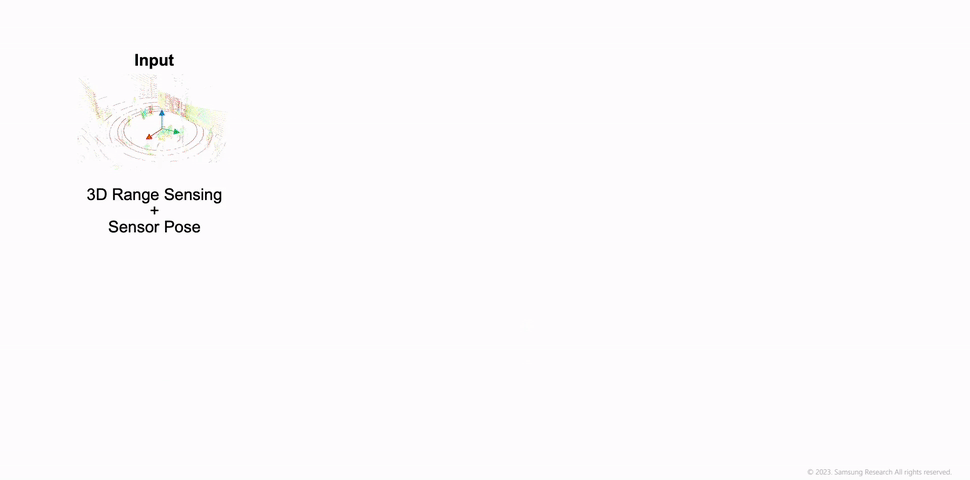Vasileios Vasilopoulos, Suveer Garg, Jinwook Huh, Bhoram Lee, Volkan Isler
This package includes the ROS implementation of HIO-SDF: Hierarchical Incremental Online Signed Distance Fields, developed by Samsung Research (Samsung AI Center - New York) and presented at ICRA 2024.
This package assumes the existence of a working ROS Noetic installation on Ubuntu 20.04. If you don't have ROS Noetic installed on your system, please refer to this guide.
-
Install system-level dependencies:
sudo apt-get install python3-catkin-tools ros-noetic-ros-numpy ros-noetic-pcl-ros -
Our method requires a method for providing coarse global SDF estimates at a low resolution. In our implementation, we use Voxfield. We have added required parameters and launch files for used datasets in a separate fork of Voxfield. Clone this Voxfield fork to your catkin workspace:
cd <path to catkin_ws>/src git clone https://github.com/vvasilo/voxfield.git -
Clone this repo to your catkin workspace:
cd <path to catkin_ws>/src git clone https://github.com/SamsungLabs/HIO-SDF.git -
Compile all packages with:
cd <path to catkin_ws> catkin build -DCMAKE_BUILD_TYPE=Release -
In your
catkin_wscreate a Python environment:python3 -m venv pyvenv source pyvenv/bin/activate pip install --upgrade pip -
Navigate to the HIO-SDF repo and set up the Python requirements:
pushd <path to catkin_ws>/src/HIO-SDF pip install -r requirements.txt popd -
Install PyTorch for your specific CUDA version. This is necessary to ensure compatibility with PyTorch3D (installed in the next step). You can check your CUDA version by running:
nvcc --version. For detailed instructions, see here: https://pytorch.org/get-started/locally/. As an example, the following command works for CUDA 11.8:pip install torch torchvision torchaudio --extra-index-url https://download.pytorch.org/whl/cu118 -
Install PyTorch3D with GPU support (this can take a long time to complete):
pip install git+https://github.com/facebookresearch/pytorch3d.git@stable
-
It might be useful to add the following function in your
.bashrcfile that automatically configures your workspace:function setup_sdf_ws() { source /opt/ros/noetic/setup.bash source <path to catkin_ws>/devel/setup.bash export ROS_MASTER_URI=http://127.0.0.1:11311 export PYTHONPATH=/usr/lib/python3/dist-packages:$PYTHONPATH export PYTHONPATH=<path to python virtual environment>/lib/python3.8/site-packages:$PYTHONPATH export LD_LIBRARY_PATH=<path to python virtual environment>/lib:$LD_LIBRARY_PATH source <path to python virtual environment>/bin/activate }
-
Activate the virtual environment:
setup_sdf_ws
For evaluation, this repository is set up to run with either the ReplicaCAD or the ScanNet dataset.
Sampled sequences from both datasets are provided by iSDF and you can download them here.
It is recommended to construct a data folder in your home directory and save all data there. We describe below the anticipated folder structure for both datasets.
To run the ScanNet sequences, you must download the ScanNet dataset. After downloading the scans, you should export the depth, color, poses and intrinsics for the sequences you wish to use, following the instructions here. Trajectory files (traj.txt) for 6 sequences from the ScanNet dataset are already provided in the above link, inside the seqs folder (scene0004_00, scene0005_00, scene0009_00, scene0010_00, scene0030_00 and scene0031_00).
Here is an example of the anticipated folder structure for the ScanNet dataset, based on the scene0030_00 sequence:
📦scene0030_00
┣ 📂color
┃ ┣ 📜0.jpg
┃ ┣ 📜1.jpg
┃ ┗ 📜...
┣ 📂depth
┃ ┣ 📜0.png
┃ ┣ 📜1.png
┃ ┗ 📜...
┣ 📂intrinsic
┃ ┣ 📜extrinsic_color.txt
┃ ┣ 📜extrinsic_depth.txt
┃ ┣ 📜intrinsic_color.txt
┃ ┗ 📜intrinsic_depth.txt
┣ 📂pose
┃ ┣ 📜0.txt
┃ ┣ 📜1.txt
┃ ┗ 📜...
┗ 📜traj.txt
6 complete ReplicaCAD sequences are already provided in the above link, inside the seqs folder (apt_2_mnp, apt_2_nav, apt_2_obj, apt_3_mnp, apt_3_nav and apt_3_obj).
The same folder contains a replicaCAD_info.json file that includes the dataset's camera intrinsics and depth scale. You should copy that file inside the folder of each environment you use.
Here is an example of the anticipated folder structure for the ReplicaCAD dataset, based on the apt_3_nav sequence:
📦apt_3_nav
┣ 📂results
┃ ┣ 📜depth000000.png
┃ ┣ 📜depth000001.png
┃ ┗ 📜...
┣ 📜replicaCAD_info.json
┗ 📜traj.txt
To generate arbitrary ReplicaCAD sequences not included in the above link, first install Habitat-Sim. Then the sequences can be generated by running this script.
The main parameters for HIO-SDF are included in this YAML configuration file.
Our algorithm needs a specification of the ROS map frame from the incoming data (map_frame in the configuration file) and subscribes to 2 topics:
- a coarse discrete SDF topic (
coarse_sdf_topic), given by Voxfield in our implementation (make sure that all "Voxfield parameters" match the used Voxfield configuration), and - a local 3D point cloud topic (
pointcloud_topic).
We provide a dataset_adapter node that reads either the ReplicaCAD or ScanNet raw data and sequentially publishes the transform of a simulated sensor frame relative to a map frame, as well as the corresponding point cloud data (generated from depth) in the /velodyne_points topic.
To run HIO-SDF:
-
Configure the
datasetparameter (ReplicaCADorScanNet) and the used datapath(pointing to your environment folder as described above) in dataset_adapter.launch. -
Launch the dataset adapter node:
roslaunch hio_sdf dataset_adapter.launch
-
Launch Voxfield. We provide 2 different launch files for each dataset format. For ReplicaCAD:
roslaunch voxblox_ros replica_voxfield.launch
Or, for ScanNet:
roslaunch voxblox_ros scannet_voxfield.launch
-
Configure the HIO-SDF parameters and launch the main node:
roslaunch hio_sdf hio_sdf.launch
If you also want to run comparisons against the ground truth, make sure to set the
do_evalparameter toTrueand supply the correct "Evaluation parameters" as described in the YAML file (ground truth SDF file, used scene, etc.). Ground truth data for some sequences are provided by iSDF in this link, inside thegt_sdfsfolder.
The provided default Voxfield and HIO-SDF parameters should work for both ScanNet and ReplicaCAD and you would only have to modify the data and output paths to match your machine's configuration.
Make sure to set the do_eval parameter to False in the HIO-SDF configuration file, and:
-
Launch Voxfield with your own configuration, based on your dataset or robot/sensor configuration.
-
Configure the main parameters to match your Voxfield configuration and launch the main node:
roslaunch hio_sdf hio_sdf.launch
This work is licensed under a Creative Commons Attribution-NonCommercial 4.0 International License (CC BY-NC).
If you find this work useful, please consider citing:
@inproceedings{vasilopoulos_hiosdf_2024,
title = {{HIO-SDF: Hierarchical Incremental Online Signed Distance Fields}},
author = {Vasileios Vasilopoulos and Suveer Garg and Jinwook Huh and Bhoram Lee and Volkan Isler},
booktitle = {IEEE International Conference on Robotics and Automation},
year = {2024},
}

